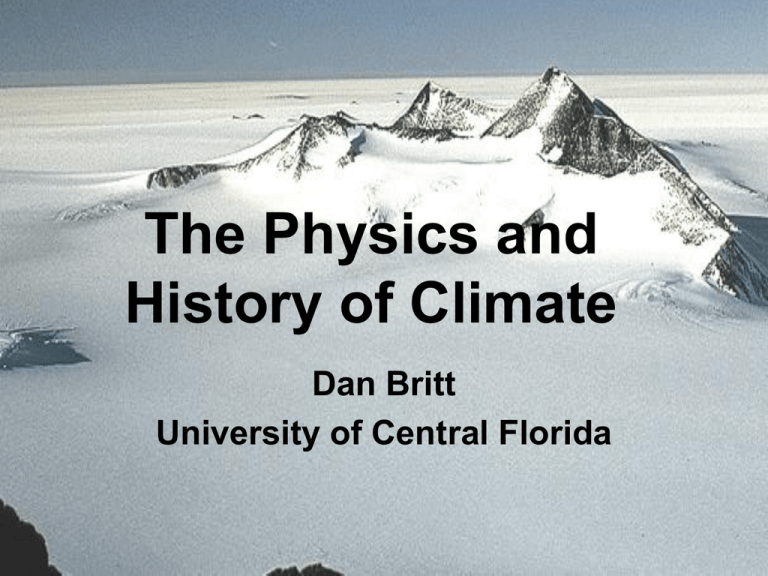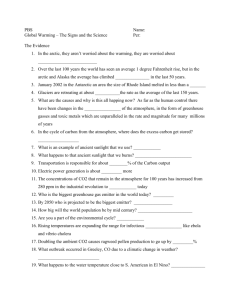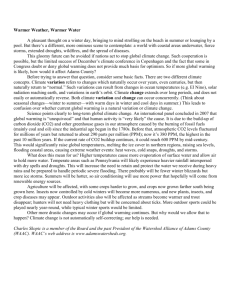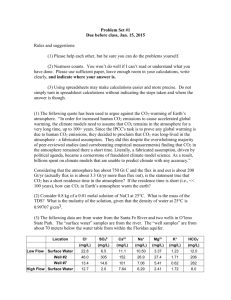Chapter5 - UCF Physics - University of Central Florida
advertisement

The Physics and History of Climate Dan Britt University of Central Florida PSC 1121 • This course is an introduction to the fundamental laws of physics using the history and dynamics of the Earth’s climate as our example and unifying theme • We will use physics to understand the nuts and bolts of how the climate works • How we know about past climates • How we can understand the changes • Textbook • Visualizing Weathering and Climate, by Bruce Anderson and Alan Strahler. • Extra readings in pdf Class Mechanics • 3 Exams: – all equal weight, 80% of grade – 2 in-class exams as listed in the schedule – A final which will be comprehensive • Quizzes: – I will give short in-class quizzes once or twice a week using a red half-sheet. Bring one to class! – There will be up to 20 quizzes. I will count 18, so you can miss 2 for free. – Quizzes will count 20% of the overall grade. • Make-up work – Only permitted for University-sanctioned activities and bona fide medical or family reasons. Class Mechanics • Extra Credit – Write a 5-page (single spaced) research paper on a climate science topic – I will provide a list of topics – Worth up to 4% extra credit • Your Professor – Office is Physical Sciences 442 – Office hours are M-W 1:30-2:30 or by appointment – Scheduling issues….. Lectures • I am not here to read you the book – I am what is called an “expert” – There are lots of important things that I think you NEED TO KNOW are NOT in the book….they will be in the lectures • I will post the powerpoints I use – http://physics.ucf.edu/~britt/Climate/ – BUT….This is NOT an on-line class – Almost every class will have a section that is NOT in the Book and will NOT be put in the on-line powerpoints….but will be on the tests. – There is no substitute for coming to class How to Get an “A” • ALL of you can get A’s in this class…..I have tenure. • How to do it #1: Attend class! – People who blow off the lectures don’t do very well….figure 30% of test questions will NOT be from the book or posted slides – Sit in the front…. • #2: Read the book! – Quizzes will tend to be on book material in advance of the lectures • #3: DO the extra credit! – That will usually up you a grade level Dr. Britt’s quirks • I ask questions….. – Correct answers get extra points. – I prowl around the class to ask questions. – I will always ask a couple of questions of those in the back row. – If you are shy, sit in the front row. • I invite you to ask questions. – You do get points for good questions…. Why am I Teaching this subject? • My “day job” is Astronomy – Background in Planetary Geology. – My work is on the geology of asteroids and comets. • I did climate work early in my career. • I was involved in taking some of the data that will be presented in this course – б18O from ice cores – б18O from Corals • I also worked with some of the founders paleoclimatology You Hear a Lot about Climate….. • • • • • • • Greenhouse gasses are warming the globe Sunspots cause warming We are in an Ice Age Glaciers are melting Glaciers are advancing Sea level is rising CO2 is natural – CO2 is a lot higher now than in the past – CO2 is a lot lower now than in the past • The Earth was a lot warmer in the past • The Earth was a lot colder in the past You Hear a Lot about Climate….. • • • • • • • Greenhouse gasses are warming the globe Sunspots cause warming We are in an Ice Age Glaciers are melting Glaciers are advancing Sea level is rising CO2 is natural – CO2 is a lot higher now than in the past – CO2 is a lot lower now than in the past • The Earth was a lot warmer in the past • The Earth was a lot colder in the past And everything here is true….. What is "Normal" for the Earth? Is today's climate NORMAL for the Earth? Weather and Climate • Weather is a set of all the phenomena occurring in a given atmosphere at a given time. – Weather occurs due to density (temperature and moisture) differences between one place to another. • Climate encompasses the meteorological factors in a given region over long periods of time Cold snaps of times past • The first Thames frost fair was in 1607; the last in 1814. • In the 1600’s ice racing became a national sport in Holland. – The major race was thru nine cities along the canals – It was last held in the 1960’s • Winter of 1780, New York Harbor froze, allowing people to walk from Manhattan to Staten Island. What is Normal? What is Normal for Sea Level? What is Normal? What is Normal? Venus Earth Earth w/o Life Carbon Dioxide 98% 0.03% 98% Nitrogen 1.9% 79% 1.9% Oxygen trace 21% trace Surface Temp 477ºC 13ºC 290 ºC Atm. Pressure (bars) 90 1.0 60 By 2.5 Billion years ago plankton were altering the oxygen content of the atmosphere Banded-Iron Formations • Caused by the oxidization of iron • Contain about 20 times the mass of the current atmosphere in oxygen • Where did the Carbon go? • Is the current level of oxygen normal? Anything Special About 21% Oxygen? Lets look at conditions during the last hot period Cretaceous: “abundance of chalk” Climate in the Cretaceous Evidence • Warm-adapted vegetation and critters north of the Arctic circle – Brown-leaf evergreens – Turtles and crocodiles • No continental glaciation • Tropical conditions to 40 – Coral growing at the paleolatitude of New York – NO HARD Freezes in temperate latitudes. • Pretty nice, but there is a down side….. Sea Level was up to 200 meters HIGHER! Why so much warmer? • CO2 – at ~1700 ppm… about 6 times pre-industrial levels • Geography – Continents closer to the equator • Ocean Circulation – Today the atmosphere transports about double the heat that the oceans transport – In Cretaceous that ratio was probably reversed FYI: Toxicity of CO2 • Current atmosphere level is ~400 ppm • OSHA says that average exposure for healthy adults during an eight-hour work day should not exceed 5,000 ppm (0.5%). • CO2 concentrations exceeding 4% are immediately dangerous to life and health. • Concentrations higher than 1,000 ppm will cause discomfort in more than 20% of occupants, and the discomfort will increase with increasing CO2 concentration. Since the Cretaceous…. • Over the past 2.7 million years the Earth’s climate has cooled and caused a series of glaciations. NORMAL for the last 500,000 years is MUCH COLDER 18,000 years ago the world was a much different place Go to Central Park, look for yourself What is the Earth’s NORMAL climate? Is this NORMAL climate? • There is NO “normal” climate • On average Earth’s climate has been MUCH warmer over the last 500 Myrs • Average means: ‒ NO continental glaciation ‒ Sea level about 350 feet higher ‒ Temperate vegetation north of the arctic circle ‒ Climate of the Keys as far north as Ohio








